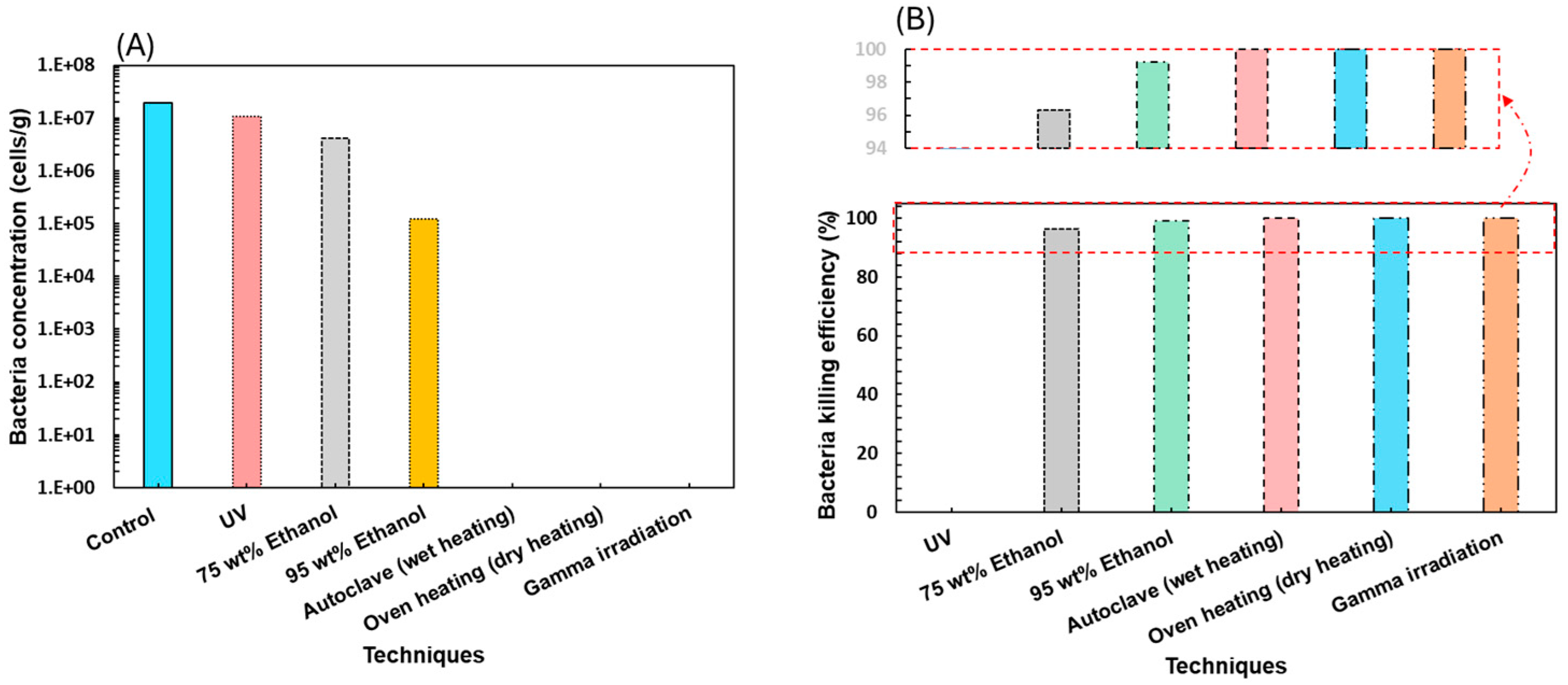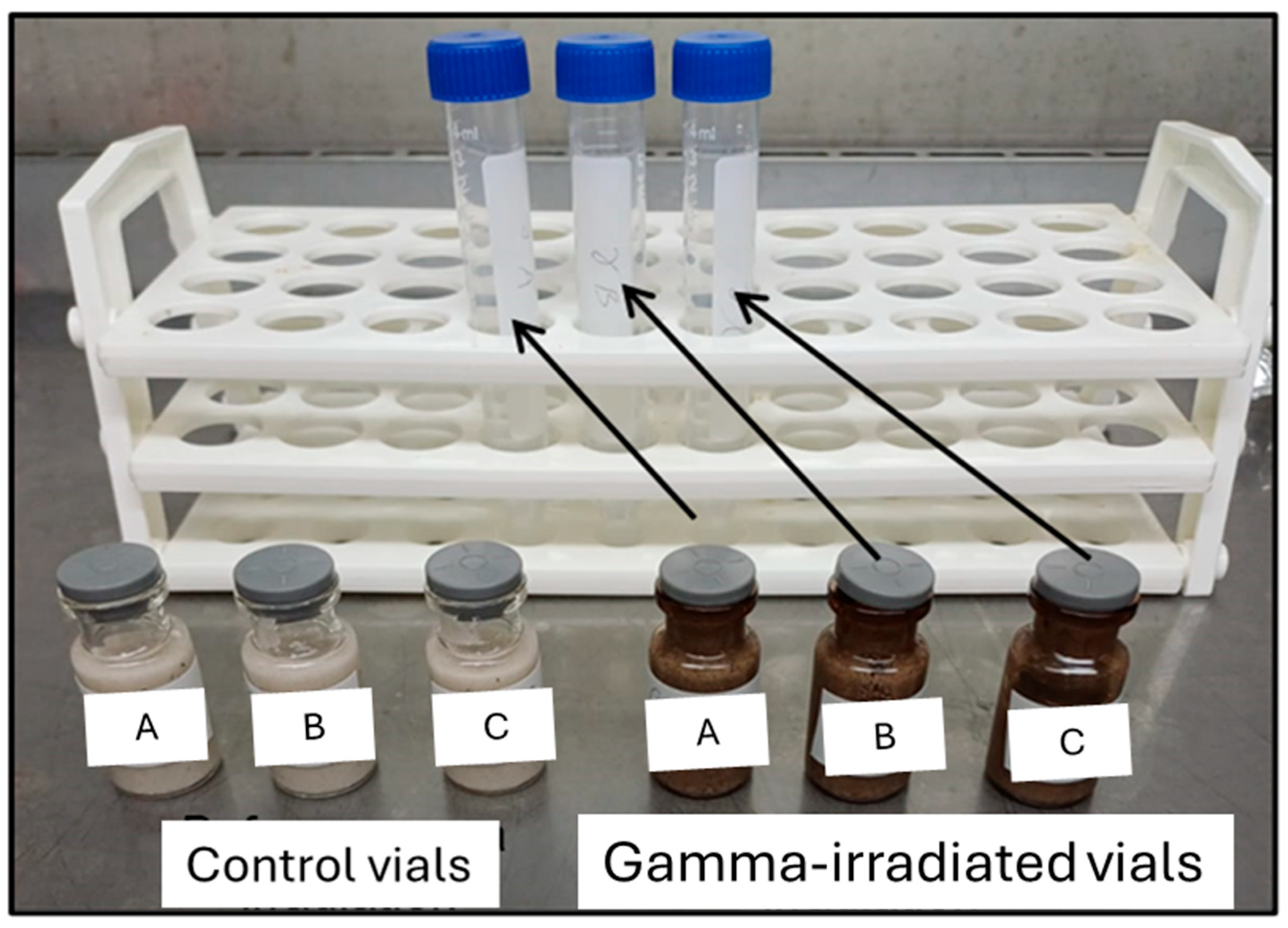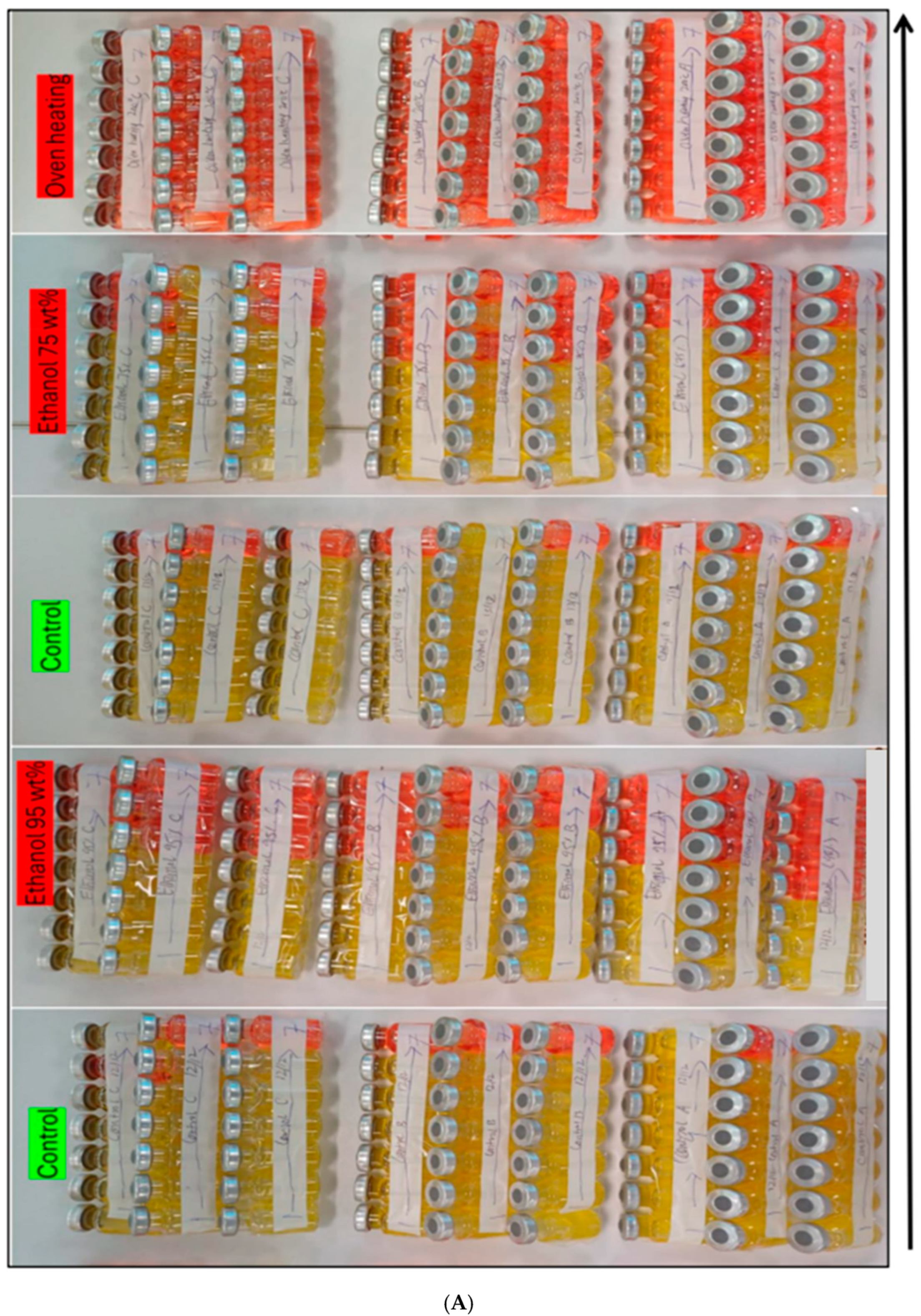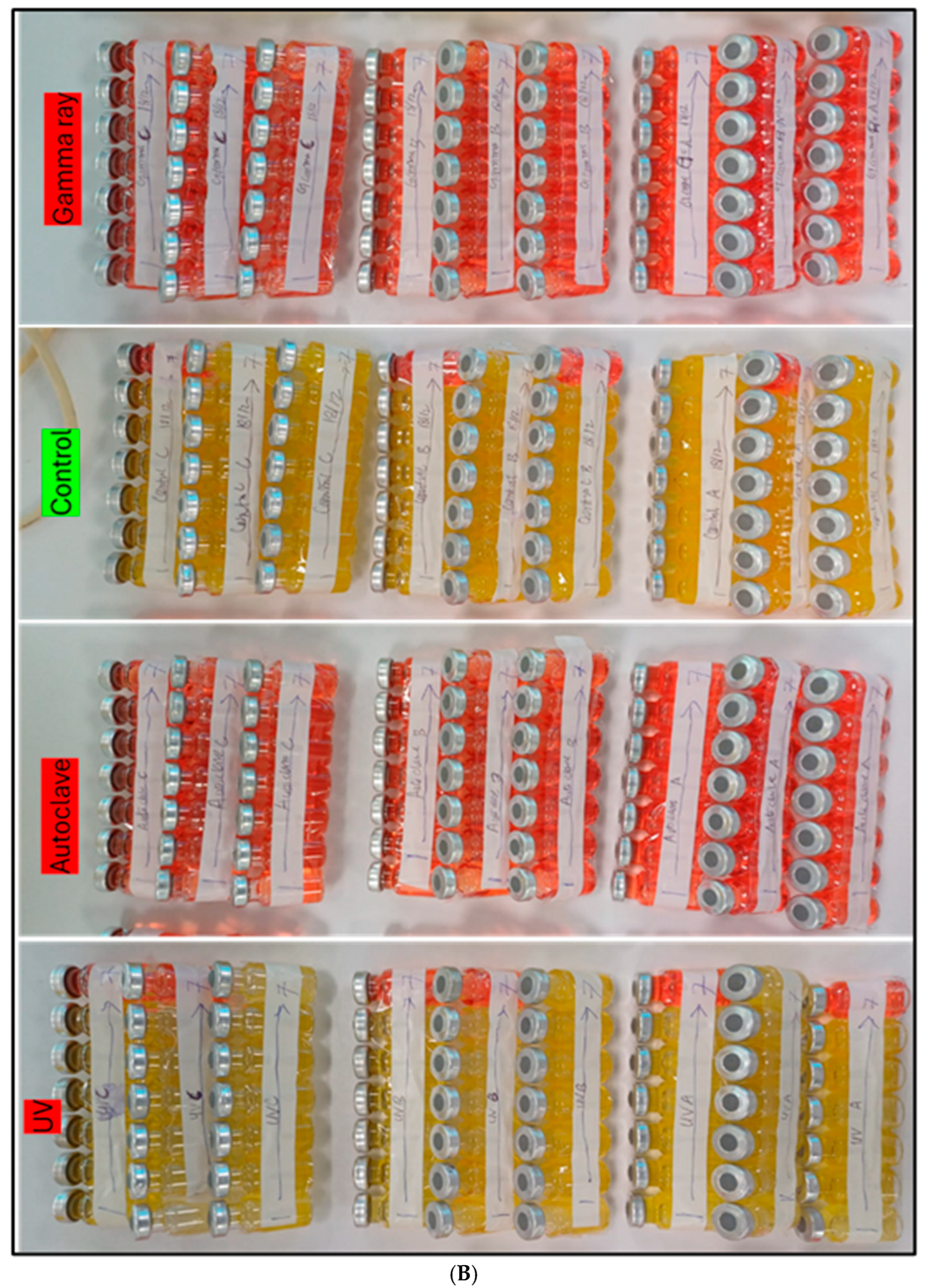Mitigating Microbial Artifacts in Laboratory Research on Underground Hydrogen Storage
Abstract
1. Introduction
2. Materials and Methods
2.1. Sand Sample Preparation
2.2. Sterilization Methods
2.3. Microbial Quantification
3. Results and Discussions
4. Conclusions
Supplementary Materials
Author Contributions
Funding
Data Availability Statement
Acknowledgments
Conflicts of Interest
References
- Truche, L.; Donzé, F.-V.; Goskolli, E.; Muceku, B.; Loisy, C.; Monnin, C.; Dutoit, H.; Cerepi, A. A deep reservoir for hydrogen drives intense degassing in the Bulqizë ophiolite. Science 2024, 383, 618–621. [Google Scholar] [CrossRef] [PubMed]
- Aftab, A.; Al-Yaseri, A.; Nzila, A.; Hamad, J.A.; Sarmadivaleh, M. Microbial impact on basalt-water-hydrogen system: Insights into wettability, capillary pressure, and interfacial tension for subsurface hydrogen storage. Greenh. Gases Sci. Technol. 2024, 14, 546–560. [Google Scholar] [CrossRef]
- Aftab, A.; Hassanpouryouzband, A.; Xie, Q.; Machuca, L.L.; Sarmadivaleh, M. Toward a fundamental understanding of geological hydrogen storage. Ind. Eng. Chem. Res. 2022, 61, 3233–3253. [Google Scholar] [CrossRef]
- Thaysen, E.M.; Butler, I.B.; Hassanpouryouzband, A.; Freitas, D.; Alvarez-Borges, F.; Krevor, S.; Heinemann, N.; Atwood, R.; Edlmann, K. Pore-scale imaging of hydrogen displacement and trapping in porous media. Int. J. Hydrog Energy 2023, 48, 3091–3106. [Google Scholar] [CrossRef]
- Aftab, A.; Hassanpouryouzband, A.; Martin, A.; Kendrick, J.E.; Thaysen, E.M.; Heinemann, N.; Utley, J.; Wilkinson, M.; Haszeldine, R.S.; Edlmann, K. Geochemical integrity of wellbore cements during geological hydrogen storage. Environ. Sci. Technol. Lett. 2023, 10, 551–556. [Google Scholar] [CrossRef] [PubMed]
- Al-Yaseri, A.; Fatah, A.; Al-Abdrabalnabi, R.; Alafnan, S.; Salmachi, A. Investigation of gas residuals in sandstone formations via X-ray core-flooding experiments: Implication for subsurface hydrogen storage. Int. J. Hydrog Energy 2024, 78, 268–278. [Google Scholar] [CrossRef]
- Gholami, R. Hydrogen storage in geological porous media: Solubility, mineral trapping, H2S generation and salt precipitation. J. Energy Storage 2023, 59, 106576. [Google Scholar] [CrossRef]
- Hassanpouryouzband, A.; Joonaki, E.; Edlmann, K.; Haszeldine, R.S. Offshore geological storage of hydrogen: Is this our best option to achieve net-zero? ACS Energy Lett. 2021, 6, 2181–2186. [Google Scholar] [CrossRef]
- Harvey, R.W.; Harms, H.; Landkamer, L. Transport of microorganisms in the terrestrial subsurface: In situ and laboratory methods. Man. Environ. Microbiol. 2007, 872–897. [Google Scholar] [CrossRef]
- van der Schoor, A.S.; Severin, J.A.; Klaassen, C.H.; Gommers, D.; Bruno, M.J.; Hendriks, J.M.; Voor, A.F.; Vos, M.C. Environmental contamination with highly resistant microorganisms after relocating to a new hospital building with 100% single-occupancy rooms: A prospective observational before-and-after study with a three-year follow-up. Int. J. Hyg. Environ. Health 2023, 248, 114106. [Google Scholar] [CrossRef]
- Ali, M.; Kumar, N.; Alsubhi, M.; Alissa, F.; Ghamdi, A.; Hoteit, H. Effects of Hydrogenated and De-Hydrogenated Organic Hydrogen Carriers on Carbonate Wettability for Hydrogen Geological Storage. Energy Fuels 2025, 39, 5550–5561. [Google Scholar] [CrossRef]
- Ali, M.; Yekeen, N.; Pal, N.; Keshavarz, A.; Iglauer, S.; Hoteit, H. Influence of pressure, temperature and organic surface concentration on hydrogen wettability of caprock; implications for hydrogen geo-storage. Energy Rep. 2021, 7, 5988–5996. [Google Scholar] [CrossRef]
- Boon, M.; Buntic, I.; Ahmed, K.; Dopffel, N.; Peters, C.; Hajibeygi, H. Microbial induced wettability alteration with implications for Underground Hydrogen Storage. Sci. Rep. 2024, 14, 8248. [Google Scholar] [CrossRef] [PubMed]
- Aftab, A.; Al-Yaseri, A.; Nzila, A.; Al Hamad, J.; Amao, A.O.; Sarmadivaleh, M. Quartz–H2–brine bacterium wettability under realistic geo-conditions: Towards geological hydrogen storage. Energy Fuels 2023, 37, 5623–5631. [Google Scholar] [CrossRef]
- Andrady, A.L. The Martian and extraterrestrial UV radiation environment—1. Biological and closed-loop ecosystem considerations. Acta Astronaut. 1999, 44, 53–62. [Google Scholar]
- Wadsworth, J.; Cockell, C.S. Perchlorates on Mars enhance the bacteriocidal effects of UV light. Sci. Rep. 2017, 7, 4662. [Google Scholar] [CrossRef]
- Volpon, A.; Elias, C.; Drozdowicz, A. An efficient device for sterilizing irregular surfaces. J. Microbiol. Methods 1990, 11, 51–58. [Google Scholar] [CrossRef]
- Johnston, V.E.; Martín-Pérez, A.; Skok, S.; Mulec, J. Microbially-mediated carbonate dissolution and precipitation; towards a protocol for ex-situ, cave-analogue cultivation experiments. Int. J. Speleol. 2021, 50, 3. [Google Scholar] [CrossRef]
- Abdelhamid, G.M.; Abdelkader, R.S.; Weesa, S.E. Streptomyces rock phosphate ore biomining evaluation in vitro. J. Environ. Radioact. 2024, 272, 107361. [Google Scholar] [CrossRef]
- Rolland, C.; Burzan, N.; Leupin, O.X.; Boylan, A.A.; Frutschi, M.; Wang, S.; Jacquemin, N.; Bernier-Latmani, R. Microbial hydrogen sinks in the sand-bentonite backfill material for the deep geological disposal of radioactive waste. Front. Microbiol. 2024, 15, 1359677. [Google Scholar] [CrossRef]
- Jenneman, G.E.; McINERNEY, M.J.; Crocker, M.E.; Knapp, R.M. Effect of sterilization by dry heat or autoclaving on bacterial penetration through Berea sandstone. Appl. Environ. Microbiol. 1986, 51, 39–43. [Google Scholar] [CrossRef] [PubMed]
- Allen, C.C.; Albert, F.G.; Combie, J.; Banin, A.; Yablekovitch, Y.; Kan, I.; Bodnar, R.J.; Hamilton, V.E.; Jolliff, B.L.; Kuebler, K. Effects of sterilizing doses of gamma radiation on Mars analog rocks and minerals. J. Geophys. Res. Planets 1999, 104, 27043–27066. [Google Scholar] [CrossRef]
- Fang, Y.; Zhang, F.; Farfan, G.A.; Xu, H. Low-temperature synthesis of disordered dolomite and high-magnesium calcite in ethanol–water solutions: The solvation effect and implications. ACS Omega 2021, 7, 281–292. [Google Scholar] [CrossRef] [PubMed]
- Seo, K.-S.; Han, C.; Wee, J.-H.; Park, J.-K.; Ahn, J.-W. Synthesis of calcium carbonate in a pure ethanol and aqueous ethanol solution as the solvent. J. Cryst. Growth 2005, 276, 680–687. [Google Scholar] [CrossRef]
- Sand, K.; Rodriguez-Blanco, J.; Makovicky, E.; Benning, L.G.; Stipp, S. Crystallization of CaCO3 in water–alcohol mixtures: Spherulitic growth, polymorph stabilization, and morphology change. Cryst. Growth Des. 2012, 12, 842–853. [Google Scholar] [CrossRef]
- Sharma, S.; Slater, L.; Ntarlagiannis, D.; Werkema, D.; Szabo, Z. Specific polarizability of sand–clay mixtures with varying ethanol concentration. Near Surf. Geophys. 2017, 15, 615–624. [Google Scholar] [CrossRef]
- Dawson, G.; Pearce, J.; Biddle, D.; Golding, S. Experimental mineral dissolution in Berea Sandstone reacted with CO2 or SO2–CO2 in NaCl brine under CO2 sequestration conditions. Chem. Geol. 2015, 399, 87–97. [Google Scholar] [CrossRef]
- Zárraga, R.; Alvarez-Gasca, D.E.; Cervantes, J. Solvent effect on TEOS film formation in the sandstone consolidation process. Silicon Chem. 2002, 1, 397–402. [Google Scholar] [CrossRef]
- Momma, N.; Kobara, Y.; Uematsu, S.; Kita, N.; Shinmura, A. Development of biological soil disinfestations in Japan. Appl. Microbiol. Biotechnol. 2013, 97, 3801–3809. [Google Scholar] [CrossRef]
- Jabarov, S.; Huseynov, R.; Ayyubova, G.S.; Trukhanov, S.; Trukhanov, A.; Aliyev, Y.; Thabethe, T.; Mauyey, B.; Kuterbekov, K.; Kaminski, G. Evaluation of structural characteristics BaFe(12-x)InxO19 hexaferrite compounds at high temperatures. Solid State Commun. 2024, 386, 115529. [Google Scholar] [CrossRef]
- Jabarov, S.; Nabiyeva, A.K.; Samadov, S.; Abiyev, A.; Sidorin, A.; Trung, N.; Orlov, O.; Mauyey, B.; Trukhanov, S.; Trukhanov, A. Study defects formation mechanism in La1-xBaxMnO3 perovskite manganite by positron annihilation lifetime and Doppler broadening spectroscopy. Solid State Ion. 2024, 414, 116640. [Google Scholar] [CrossRef]
- Hajpál, M.; Török, Á. Mineralogical and colour changes of quartz sandstones by heat. Environ. Geol. 2004, 46, 311–322. [Google Scholar] [CrossRef]
- Gamliel, A.; Austerweil, M.; Kritzman, G. Non-chemical approach to soilborne pest management–organic amendments. Crop Prot. 2000, 19, 847–853. [Google Scholar] [CrossRef]
- Bank, T.L.; Kukkadapu, R.K.; Madden, A.S.; Ginder-Vogel, M.; Baldwin, M.; Jardine, P. Effects of gamma-sterilization on the physico-chemical properties of natural sediments. Chem. Geol. 2008, 251, 1–7. [Google Scholar] [CrossRef]
- Querejeta, G.A. Sterilize methods comparison for soils: Cost, time, and efficiency. Int. J. Methodol. 2023, 2, 34–40. [Google Scholar] [CrossRef]
- King, W.L.; Grandinette, E.M.; Trase, O.; Rolon, M.L.; Salis, H.M.; Wood, H.; Bell, T.H. Autoclaving is at least as effective as gamma irradiation for biotic clearing and intentional microbial recolonization of soil. Msphere 2024, 9, e0047624. [Google Scholar] [CrossRef]






| Sterilization Technique | Overall Effect on Mineralogy | Geoscience Applications | Astrobiology Applications | Study |
|---|---|---|---|---|
| UV |
|
|
| [15,16,17] |
| 75% ethanol and 95% ethanol |
|
| Nil | [23,24,25,26,27,28] |
| Solarization | Soil |
| Nil | [29] |
| Oven heating |
|
| Nil | [32] |
| Autoclave |
|
| Nil | [33] |
| Gamma Irradiation |
| Physico-chemical properties of natural sediments:
| Mars-returned rock samples sterilization:
| [22,34] |
| Techniques | Temperature | Pressure | Intensity | Exposure Time | Concentration |
|---|---|---|---|---|---|
| UV irradiation | Ambient | Ambient | 280 to 100 nm | 30 min both sides | NA |
| Autoclave | 121 °C | 15 psi | NA | 30 min | NA |
| Oven heating | 200 °C | Ambient | NA | 2 h | NA |
| Ethanol washing | Ambient | Ambient | NA | 15 min × 3 times | 75 wt% 95 wt% |
| Gamma irradiation | NA | NA | NA | 32 h | NA |
Disclaimer/Publisher’s Note: The statements, opinions and data contained in all publications are solely those of the individual author(s) and contributor(s) and not of MDPI and/or the editor(s). MDPI and/or the editor(s) disclaim responsibility for any injury to people or property resulting from any ideas, methods, instructions or products referred to in the content. |
© 2025 by the authors. Licensee MDPI, Basel, Switzerland. This article is an open access article distributed under the terms and conditions of the Creative Commons Attribution (CC BY) license (https://creativecommons.org/licenses/by/4.0/).
Share and Cite
Aftab, A.; Salgar-Chaparro, S.J.; Xie, Q.; Saeedi, A.; Sarmadivaleh, M. Mitigating Microbial Artifacts in Laboratory Research on Underground Hydrogen Storage. Fuels 2025, 6, 52. https://doi.org/10.3390/fuels6030052
Aftab A, Salgar-Chaparro SJ, Xie Q, Saeedi A, Sarmadivaleh M. Mitigating Microbial Artifacts in Laboratory Research on Underground Hydrogen Storage. Fuels. 2025; 6(3):52. https://doi.org/10.3390/fuels6030052
Chicago/Turabian StyleAftab, Adnan, Silvia J. Salgar-Chaparro, Quan Xie, Ali Saeedi, and Mohammad Sarmadivaleh. 2025. "Mitigating Microbial Artifacts in Laboratory Research on Underground Hydrogen Storage" Fuels 6, no. 3: 52. https://doi.org/10.3390/fuels6030052
APA StyleAftab, A., Salgar-Chaparro, S. J., Xie, Q., Saeedi, A., & Sarmadivaleh, M. (2025). Mitigating Microbial Artifacts in Laboratory Research on Underground Hydrogen Storage. Fuels, 6(3), 52. https://doi.org/10.3390/fuels6030052








